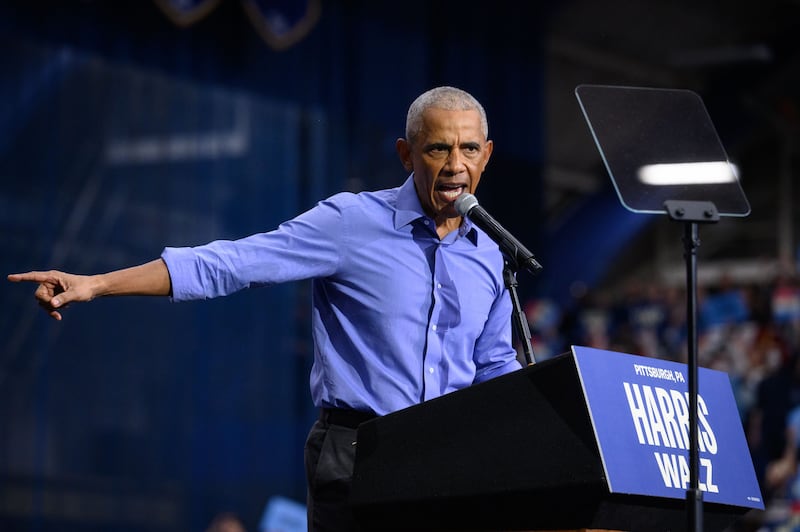Sixty-seven million people watched Kamala Harris debate against Donald Trump in Philadelphia a month ago. It’s a whopping number. There was a moment in that event when the Republican candidate, addled throughout, found himself repeating the grotesque claim about migrants eating cats and dogs. “It was on TV,” he blurted out.
That moment was the high-water mark of the Harris campaign. Her sparring, mirthful performance was masterful and substantive, and afterwards prominent Democrats rushed to champion her. It was a startling reversal in fortune: the Republican campaign, all but unassailable in its post-assassination-attempt hues of mid-July, had lost its bearings.
But that is a distant memory. The Democratic movement is worried. The Republicans have regained traction, unhinging their opponents by presenting JD Vance in nice-guy mode in his vice-presidential debate with Tim Walz, while seemingly submitting to Trump’s strategy that the best path to the White House is through a campaign based on saying everything and anything to spread fear and doubt among undecided voters.
On Friday morning, Harry Enten, CNN’s affable data reporter, offered a brief snapshot as to why the Democrats are nervous. Just a fortnight ago, Harris had a two-point lead in Pennsylvania and Wisconsin. She enjoyed a three-point lead in Michigan. But now, each of these states has been reduced to an all-but-invisible one-point advantage. The hundreds of millions of dollars spent on adverts, on rallying, on door-to-door campaigning: nothing, it seems, is moving the numbers. The candidates are deadlocked.
And looking at the average of all three states on October 11th in previous elections makes for nerve-racking fun for the Democrats. In 2020, Joe Biden had an average seven-point lead in those states. He scraped through in all three. Hillary Clinton was ahead by an average of eight points at this point in 2016. She lost all three states, narrowly, to Trump. Trusting the numbers was the great mistake of the Clinton campaign, which did not factor in the importance of having their candidate touch ground in the states often enough: to show the voters the respect of turning up.
The past week has seen Harris engage in a series of high-profile media interviews, from high-ratings podcasts to the establishment staple Sixty Minutes to the late-night talk show chair of habitual Trump-mocker Stephen Colbert, with whom she cracked open a Miller High Life.
It is debatable whether those appearances furthered Harris in her quest to become a better-known entity among voters. Trump has been around for so long and is such a voluble force of nature that he lives in the subconscious of all Americans, whether they love or loathe him. Few public figures have the power to make that leap and Harris is attempting to do so in just 100 days. She is also hoping that America is ready to put a woman in the White House – let alone a woman whose parents were immigrants from India and Jamaica.
[ Kamala Harris is a descendant of an Irish slave owner in JamaicaOpens in new window ]

Republican strategists have interpreted this flurry of media activity as an alarmed response by Democrats to private, internal polling. The same response was offered when Barack Obama began what will be a sustained tour of the battleground states to campaign for Harris in Pittsburgh on Thursday. At a pre-rally stop in a Democrat campaign office, footage emerged showing the former president all but rebuking volunteers for the absence of “the same kinds of energy and turnout in all quarters of our neighbourhoods” when he was running and noted that the apathy seemed particularly noticeable among the “brothers”.
“So now you’re thinking about sitting out or even supporting somebody who has a history of degrading you? Because you think that’s a sign of strength? Because that’s what being a man is, putting women down? That’s not acceptable.”
[ Nobody gets under Donald Trump’s skin like Barack ObamaOpens in new window ]
But you only had to watch Obama speaking on stage to understand the reason why the energy is not the same. He has a once-in-a-lifetime gift for awakening hope among the masses. The trouble with having Obama making public appearances like this is that he makes everybody else look like cardboard. But the observation that Obama, a full eight years out of office, won’t reach that younger demographic who don’t fully remember his original coming doesn’t hold. Even for new voters, with little memory of the Obama years, he still presents a compelling persona.
But will he help to give the Democrats the crucial edge? The arguments rage as to why the Democratic campaign appears to have lost the momentum that Harris enjoyed in August, when the faithful held a party convention framed around the word “joy”. One argument is that since then, the message has become too careful and too moderate. The conservative-leaning Wall Street Journal offered its answer through a Friday editorial: “It’s that she hasn’t shown voters that she is her own woman,” the board opined.
“Her campaign of ‘vibes’ and safe appearances suggests she will be, like Mr Biden has been, a captive of her party and its unpopular policies. Even if they disagree with him, voters can’t say Donald Trump hasn’t put his stamp on his party and the issues.”
That’s a delicate description of the shock-and-awe reconstruction of the Republican party under Trump. But it is definitely true that his message has been consistent. Nailing down a clear message of her own, one that will carry through the loudening din of the next 23 days is, clearly, the vital task facing Kamala Harris and her campaign team. How best to do that is the trickier proposition.
















